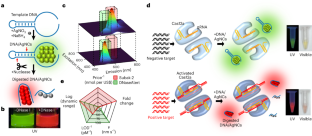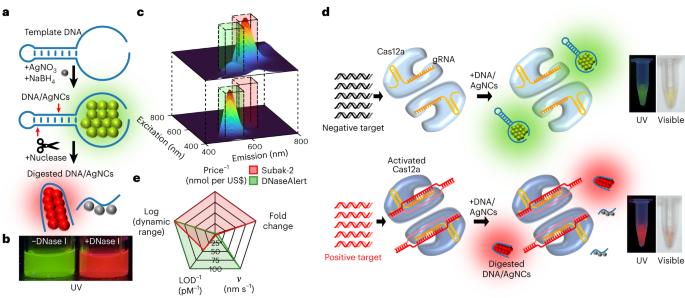A non-FRET DNA reporter that changes fluorescence colour upon nuclease digestion
IF 38.1
1区 材料科学
Q1 MATERIALS SCIENCE, MULTIDISCIPLINARY
引用次数: 0
Abstract
Fluorescence resonance energy transfer (FRET) reporters are commonly used in the final stages of nucleic acid amplification tests to indicate the presence of nucleic acid targets, where fluorescence is restored by nucleases that cleave the FRET reporters. However, the need for dual labelling and purification during manufacturing contributes to the high cost of FRET reporters. Here we demonstrate a low-cost silver nanocluster reporter that does not rely on FRET as the on/off switching mechanism, but rather on a cluster transformation process that leads to fluorescence color change upon nuclease digestion. Notably, a 90 nm red shift in emission is observed upon reporter cleavage, a result unattainable by a simple donor-quencher FRET reporter. Electrospray ionization–mass spectrometry results suggest that the stoichiometric change of the silver nanoclusters from Ag13 (in the intact DNA host) to Ag10 (in the fragments) is probably responsible for the emission colour change observed after reporter digestion. Our results demonstrate that DNA-templated silver nanocluster probes can be versatile reporters for detecting nuclease activities and provide insights into the interactions between nucleases and metallo-DNA nanomaterials. Here the authors present a non-FRET DNA-templated silver nanocluster probe that exhibits a distinct colour switch from green to red upon nuclease digestion, visible under UV excitation, offering a low-cost, effective alternative to fluorescent reporters for detecting nuclease activities.


一种非FRET DNA 报告器,可在核酸酶消化时改变荧光颜色。
荧光共振能量转移(FRET)报告物通常用于核酸扩增测试的最后阶段,以指示核酸靶标的存在,荧光会被裂解 FRET 报告物的核酸酶恢复。然而,由于在生产过程中需要进行双重标记和纯化,导致 FRET 报告物的成本居高不下。在这里,我们展示了一种低成本的纳米银团簇报告物,它不依赖 FRET 作为开关机制,而是依赖团簇转化过程,在核酸酶消化后导致荧光颜色变化。值得注意的是,当报告器被裂解时,会观察到 90 nm 的发射红移,这是简单的供体-淬火器 FRET 报告器无法达到的结果。电喷雾离子化-质谱分析结果表明,银纳米簇的化学计量从 Ag13(在完整的 DNA 宿主中)变为 Ag10(在片段中),这可能是在报告物消化后观察到的发射颜色变化的原因。我们的研究结果表明,以 DNA 为载体的纳米银簇探针可以成为检测核酸酶活性的多功能报告物,并为核酸酶与金属-DNA 纳米材料之间的相互作用提供了深入的见解。
本文章由计算机程序翻译,如有差异,请以英文原文为准。
求助全文
约1分钟内获得全文
求助全文
来源期刊

Nature nanotechnology
工程技术-材料科学:综合
CiteScore
59.70
自引率
0.80%
发文量
196
审稿时长
4-8 weeks
期刊介绍:
Nature Nanotechnology is a prestigious journal that publishes high-quality papers in various areas of nanoscience and nanotechnology. The journal focuses on the design, characterization, and production of structures, devices, and systems that manipulate and control materials at atomic, molecular, and macromolecular scales. It encompasses both bottom-up and top-down approaches, as well as their combinations.
Furthermore, Nature Nanotechnology fosters the exchange of ideas among researchers from diverse disciplines such as chemistry, physics, material science, biomedical research, engineering, and more. It promotes collaboration at the forefront of this multidisciplinary field. The journal covers a wide range of topics, from fundamental research in physics, chemistry, and biology, including computational work and simulations, to the development of innovative devices and technologies for various industrial sectors such as information technology, medicine, manufacturing, high-performance materials, energy, and environmental technologies. It includes coverage of organic, inorganic, and hybrid materials.
 求助内容:
求助内容: 应助结果提醒方式:
应助结果提醒方式:


